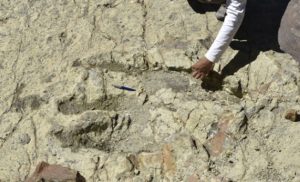
It’s not easy following in the footsteps of the largest animals ever to roam Earth.
There are no roads or even footpaths to get to the spot in Bolivia where researchers recently discovered a huge dinosaur footprint measuring 1.15 meters (nearly four feet) wide.
But Bolivian paleontologist Omar Medina hopes to turn this remote corner of southern Bolivia into a magnet of paleontology that will attract visitors from around the world.
The enormous footprint, roughly 80 million years old, was discovered last month by local guide Grover Marquina, who specializes in fossil tours.
It was left by an abelisaurid theropod dinosaur, a carnivorous biped that Medina estimates would have been about 15 meters tall.
The size and quality of the print are “impressive—never seen before,” Medina said.
“It allows us to position ourselves as a mecca of paleontology.”
The footprint, which dates to the Late Cretaceous Period, is just the most recent find in Bolivia’s Chuquisaca department, a hot bed of dinosaur fossils.
Visitors can also see dozens of dinosaur footprints that appear to scale the wall of a cliff. They were in fact left when the sheer rock face was flat ground, before the churning of the Earth’s plates turned it upright.
There are also fossils from what may have been the world’s last glyptodon, an enormous armadillo-like animal that lived during the Pleistocene era (11,700 to 2.6 million years ago).
“Every discovery is very important because every fossil we find isn’t just another fossil, it’s an icon for the world,” Medina told AFP.
Today, Chuquisaca sits in the landlocked South American country’s southern highlands, but millions of years ago it was a hot coastal region.
Paleontologists from around South America will visit Chuquisaca in October to study the region’s fossil treasures.
Bolivia is already known for the region’s Cal Orcko Park, one of the world’s largest beds of fossilized footprints, which has more than 10,000 prints left by nearly 300 species of dinosaur.
But Maragua, where Marquina discovered the giant abelisaurid theropod print, is far more remote.
“There are no basic services to bring people here to show them these paleontological riches,” Marquina said.
“We have to blaze a trail.”
Note: The above post is reprinted from materials provided by AFP.










